⭐ BEST FERRY via CEBU & Countryside Tour: Our pick for Ferry Tickets and Countryside Tours.
- Bohol
- Bohol Attractions
- Tarsiers
Bohol Tarsiers: Discover the World's Smallest Primates

Join us on an exciting adventure through the captivating forests of Bohol to witness the extraordinary tarsiers up close. These incredible creatures, found in the viney forests of Southeast Asia, will leave you in awe with their unique characteristics.
Bohol Tarsiers (Tarsius Syrichta) are truly extraordinary creatures that will leave you in awe. Measuring only 4 to 5 inches in size and weighing a mere 113 to 142 grams, they hold the title of the world's smallest primate. These fascinating primates belong to the more primitive sub-order Prosimii, with a lineage dating back an impressive 45 million years.
Don't miss out on this unforgettable experience - Book your tour now!
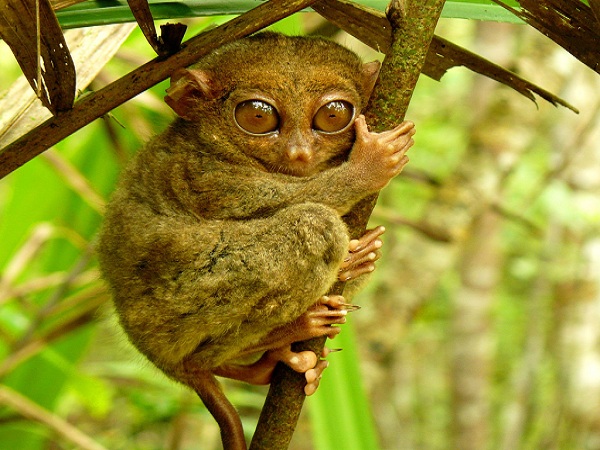 Bohol tarsiers
Bohol tarsierssome captivating facts about tarsiers
- Habitat: Explore the lush viney forests of Bohol, where tarsiers make their home. These forests provide the perfect environment for their survival.
- Location: Embark on a journey to Bohol to encounter these mesmerizing creatures in their natural habitat.
- Lifespan: Marvel at the tarsier's lifespan, which ranges from 12 to 20 years, allowing for a longer opportunity to observe their fascinating behaviors.
- Size: Witness the petite size of tarsiers, measuring between 10 to 15 cm in length, with their slender tails extending up to 25 cm. Don't let their small stature deceive you, as they are full of astonishing abilities.
- Weight: Discover the lightweight nature of tarsiers, weighing in at only 80 to 180 grams, making them agile and nimble in their movements.
- Color: Admire the captivating colors of these charming creatures, as they display shades of beige or orange, blending harmoniously with their surroundings.
- Diet: Learn about their diverse diet, which consists of a variety of insects such as spiders, beetles, ants, moths, caterpillars, crickets, grasshoppers, cockroaches, termites, and walking stick bugs.
- Predators: Understand the challenges they face in their ecosystem, as tarsiers must evade predators like snakes, owls, and lizards, highlighting their impressive survival skills.
- Top Speed: Be amazed by their agility as they dash through the forest, reaching speeds of up to 15.5 km/h (25 mph). Witness their incredible speed firsthand.
- Species and Conservation: Discover that there are over 13 living species of tarsiers in the world today. However, due to various threats, including habitat loss, these remarkable creatures are considered endangered. By joining our tours, you contribute to their conservation efforts and help protect these captivating creatures for future generations.
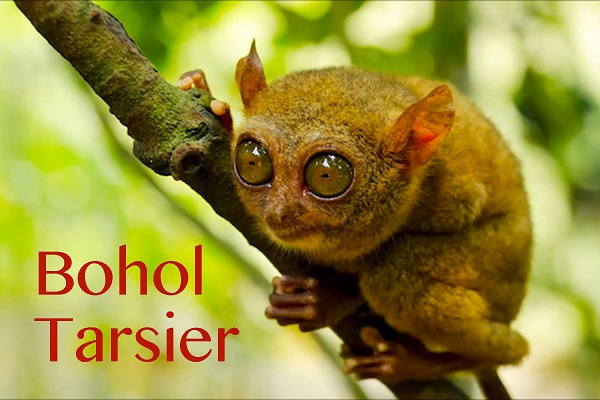 Bohol tarsiers
Bohol tarsiersBohol Tarsiers: Mind-Blowing Facts!
1. Experience the Primate Venom: Join us on an extraordinary journey to discover the captivating Bohol Tarsiers, the only venomous primate on Earth! Witness their unique defense mechanism as they secrete a potent toxin from a gland in their arm. This venomous bite, combined with their hissing and other behaviors, has evolved to mimic venomous snakes. Prepare to be amazed!
2. The Bashful Marvels: Prepare to be fascinated by the shy nature of tarsiers. These remarkable creatures are notorious for their bashfulness, making them easily stressed. Even the slightest disturbance, such as being touched or confined in cages, can be detrimental to their well-being. Understand why it is considered unethical to keep them in captivity for extended periods or non-conservation purposes.
3. Diverse Tarsier Species: Immerse yourself in the diversity of tarsiers as you explore their world. With over a dozen species and numerous subspecies, these primates can be found across Maritime Southeast Asia. Join us on an adventure through the enchanting countries of the Philippines, Malaysia, Indonesia, and Brunei to encounter these extraordinary creatures in their natural habitat.
4. The Window to Their Souls: Marvel at the incredible eyes of tarsiers, which can be as large as 16 millimeters in diameter. These mesmerizing eyes, larger than their brains, enable them to optimize their vision in the darkness of the night. Witness their unique skull structure, specially adapted to support the weight of their magnificent eyes, and be awestruck by this exceptional adaptation.
5. A Head Spin Like No Other: Prepare to be amazed as tarsiers demonstrate their exceptional neck flexibility, reminiscent of owls. With the ability to rotate their heads a full 180 degrees, these primates possess a remarkable field of view, covering a complete 360 degrees. Sneaking up on them is nearly impossible! Witness their incredible agility firsthand on our captivating tours.
6. Ultrasonic Hearing Prowess: Discover the astonishing auditory capabilities of tarsiers, particularly the Philippine tarsier. These fascinating creatures can hear frequencies as high as 91 kHz, surpassing the hearing capacity of most animals, including dogs. Immerse yourself in their unique world of ultrasonic communication.
7. The Carnivorous Primates: Brace yourself for an intriguing revelation – tarsiers are the only entirely carnivorous primates! Unlike their primate counterparts, these insectivores exclusively feast on insects, showcasing their specialized hunting skills. Explore their hunting techniques and the variety of prey they pursue, including birds, small reptiles, and bats.
8. United Against Threats: Delve into the complex social dynamics of tarsier groups. Although typically consisting of a single male, known as the alpha male, these primates display remarkable teamwork when facing predators. When a threat arises, multiple groups may unite, launching coordinated attacks with their venomous bites. Witness the power of their collective defense strategies.
9. Leaps of Extraordinary Proportions: Prepare to be astonished by the extraordinary leaping abilities of tarsiers. With hind legs twice as long as their bodies, these primates are built for impressive jumps. They effortlessly spring between trees and branches, covering distances over 5 meters – that's a staggering 40 times their own body length! Marvel at their exceptional athleticism.
10. The Delicate Balance: Learn about the conservation challenges faced by tarsiers, as their habitats rapidly diminish, placing them at risk of extinction. Understand the vital role of focused and wide-ranging conservation efforts in preserving these extraordinary creatures. By joining our tours, you actively contribute

Unique Traits of Bohol Tarsiers
Bohol Tarsiers possess captivating features that make them truly remarkable. With tails longer than their bodies, large brown eyes, hairless ears, and finger-like claws, they captivate all who encounter them. Their gray fur and nearly naked tails, approximately 232 mm in length, gracefully arc over their backs as they traverse the ground, ensuring perfect balance. Interestingly, the underside of their tails boasts dermal ridges similar to those found on human hands and feet.
The mesmerizing eyes of tarsiers are a true marvel. Their bony eye sockets surpass both their brain case and stomach in size. Equipped with post-orbital closure, these unique primates prevent their eyeballs from being compressed by the powerful temporal muscles at their sides.
Much like owls, tarsiers possess the ability to rotate their heads a full 180 degrees in each direction. This exceptional neck flexibility is made possible by a joint between their skull base and spine. Additionally, tarsiers have muscular upper lips that allow for facial expressions. Their adult brains weigh approximately 4 grams, showcasing their remarkable cognitive abilities.
Bohol Tarsiers are equipped with sharp teeth, enabling them to capture their prey with ease. Interestingly, they possess only two incisors in their lower jaw, distinguishing them from other primates. Their dental formula is 2.1.3.3 1.1.3.3 x 2 = 34.
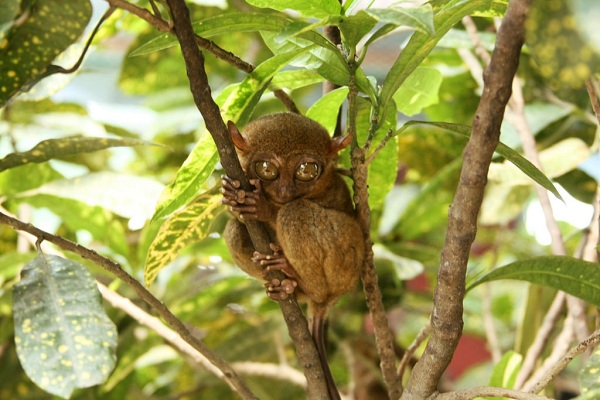 Bohol tarsiers
Bohol tarsiersExtraordinary Leaping Abilities & Nocturnal Habits
Prepare to be amazed by the extraordinary leaping abilities of Bohol Tarsiers. With hind legs twice as long as their bodies, these primates are built for remarkable jumps. Their elongated tarsal bones, forming their ankles, empower them to leap heights of up to 10 feet, effortlessly maneuvering from tree to tree. The name "tarsier" itself is derived from the word "tarsal," highlighting their exceptional leaping prowess.
Bohol Tarsiers are nocturnal creatures, much like owls. They are active during the night while finding refuge in hollows close to the ground during the day. Their diet primarily consists of fruits and insects such as cockroaches, crickets, and small lizards. Interestingly, local beliefs associate tarsiers with eating charcoal, but in reality, they consume the insects or maggots found within burnt wood or seek out salt sources.
Ready to explore the beautiful islands of Cebu and Bohol? Secure your ferry tickets today through 12go and start your unforgettable journey!

Conservation Challenges and Preservation Efforts
Sadly, tarsiers face significant threats and are vulnerable to extinction. Once inhabiting rainforests worldwide, they are now confined to the islands of the Philippines, Borneo, and Indonesia. Deforestation resulting from legal and illegal logging, as well as slash-and-burn agricultural practices, has greatly diminished their natural habitat. Additionally, poaching for the sale of stuffed tarsiers to tourists has further endangered their population.
To the locals, Bohol tarsiers are known by various names, including "mamag," "mago," "maomag," "magau," "malmag," and "magatilok-iok." Their classification places them in the class "Mammalia," under the order of primates, specifically in the suborder prosimii/haplorrhini and infraorder tarsiiformes of the superfamily tarsioidea. While often mistakenly referred to as "the world's smallest monkey," tarsiers share some characteristics with monkeys and apes but belong to the suborder anthropoids.
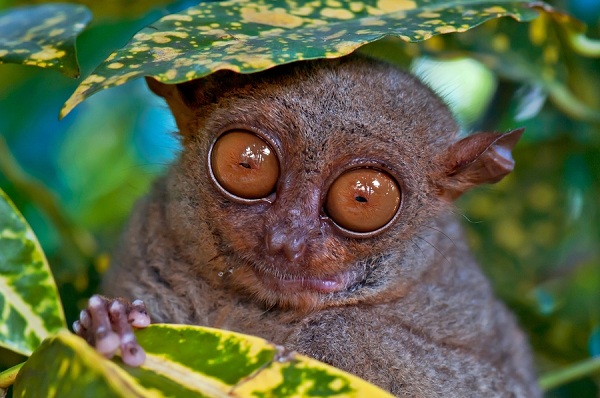
Discover the Nocturnal Life of Tarsiers
As nocturnal creatures, Bohol tarsiers share similarities with owls, sleeping during the day and becoming active at night. They seek refuge in hollows close to the ground, using these hiding spots as their safe havens. Their diet primarily consists of fruits and insects, including cockroaches, crickets, and occasionally small lizards. It's worth noting that locals have misconceptions about their diet, believing they consume charcoal, when in reality, they are after the insects or maggots within burnt wood or seeking sources of salt.
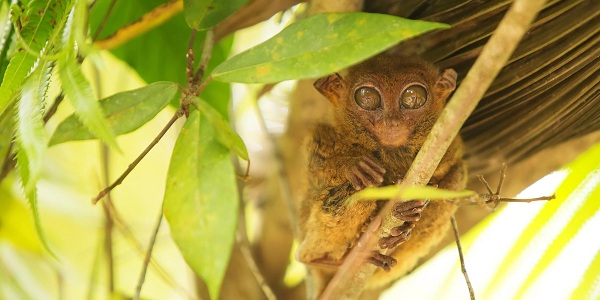
Fascinating Behaviors and Remarkable Reproduction
When it comes to vocalizations, Bohol tarsiers have a distinct and piercing cry that echoes through the night. During gatherings, they produce a chorus of chirping sounds reminiscent of locusts. In moments of contentment, tarsiers emit soft, sweet birdlike twills that add to the enchantment of their presence. Living in groups, they form social bonds beyond a mere male and female pairing.
The responsibility of caring for the young falls solely on the female tarsiers, as no male parental care has been observed. Male tarsiers possess epigastric glands, which they utilize for scent marking. Females emit a special sound to signal their fertility.
Female tarsiers exhibit a unique reproductive system, with a prosimian-type uterus and a placenta resembling those found in higher primates. An intriguing feature is the presence of multiple breast pairs, although typically only the pectoral pair functions as a milk source. The additional breast pairs serve as anchoring points for the newborns.
The gestation period for tarsiers spans approximately 180 days (6 months), resulting in the birth of a single offspring. Remarkably, newborn tarsiers enter the world in an advanced state of development. They are born fully furred, with their eyes wide open. At birth, their head and body length measure between 66 and 72 mm, while the tail reaches 114 to 117 mm in length. They weigh around 25 to 27 grams.
Within just two days, tarsier infants display remarkable mobility. The mother carries them using her mouth or on her belly, and no nest is constructed. While foraging, the female parks her infant nearby. Within a matter of days, young tarsiers acquire climbing skills, and after approximately four days, they can already jump with agility. Around 19 days after birth, they exhibit movements akin to adult tarsiers. The young are breast-fed for about 60 days, fostering their growth and development. Juveniles often display more uniform coloration compared to adults, adding to their charm.

By joining our tours and supporting tarsier conservation efforts, you play a crucial role in safeguarding these remarkable creatures and preserving their habitats. Book your tour today and contribute to the protection of Bohol tarsiers for generations to come! [Book your tour now!]
Revealing the Conservation Challenges Faced by Tarsiers:
After reaching two years of age, young tarsiers enter their sexual maturity phase. Female tarsiers experience an estrus cycle, or period of heat, occurring every 23.5 days. Mating can occur at any time of the year. These captivating creatures have an average lifespan of up to 20 years.
Tarsiers in captivity display a tame nature and are often found huddled together, with their tails intertwined. Their endearing presence invites gentle interactions, allowing them to be fondled and run up one's arms to the shoulders and back. Their ticklish nature adds to their charm, but they are easily frightened, quickly scurrying back to the safety of shrubs and hiding spots. In captivity, tarsiers can be fed live shrimp and fish in a water-filled bowl, providing for their dietary needs.
It is important to note that only five species of tarsiers exist, with four of them found in Indonesia. The species Tarsius Syrichta resides deep in the woods of Bohol Island in the Visayas, Philippines. These small furry creatures can also be found in the islands of Samar, Leyte, and Mindanao.
In the past, tarsiers inhabited rainforests worldwide. However, their presence has significantly dwindled, and they now exist only in select areas, including the islands of the Philippines, Borneo, and Indonesia. In the 1960s, tarsiers were a common sight in the southern part of Bohol, but today, it is estimated that only around 1,000 individuals remain in the wild.
These captivating creatures were once protected by the lush rainforests and mist-shrouded hills. However, their populations have suffered due to the destruction of their natural habitats caused by both legal and illegal logging practices, as well as slash-and-burn agricultural methods, which have greatly reduced forested areas. Additionally, tarsiers have fallen victim to poachers who capture them for sale as stuffed tarsier mementos to unsuspecting tourists.
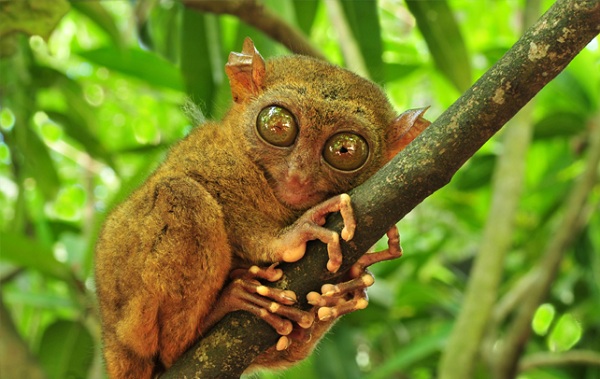
Diversity of Tarsiers in the Philippines & Beyond
Tarsiers found in different regions of the Philippines exhibit slight variations. In Samar and Leyte, they are known as "T. philippensis," while in Bohol, they are called "T. fraterculus." In Mindanao, they are referred to as "T. carbonarius." It is believed that these species in the Philippines are of the same kind but have developed into three distinct races due to geographical separation and habitat adaptation.
Beyond the borders of the Philippines, tarsiers have relatives found in Borneo, Sumatra, and Indonesia. Borneo is home to the tarsius bancanus, while Sumatra boasts the presence of tarsius spectrum and tarsius pumilus. In Sulawesi, Indonesia, the tarsius dianae thrives. Notably, the pygmy tarsier (tarsius pumilus) is much smaller in size compared to the Philippine tarsier.
These fascinating variations and the distribution of tarsiers across different regions highlight the intricacies of evolution, adaptation, and speciation. By exploring these diverse populations, we gain a deeper understanding of the remarkable journey and unique characteristics of these captivating creatures.

The Tarsier Man - Carlito Pizarras is known in Corella as the Tarsier Man. He is at present the field officer of the Philippine Tarsier Foundation, Inc. (PTFI).
The Philippine Tarsier Foundation, Inc. - The Philippine Tarsier Foundation, Incorporated (PTFI) is a non-stock, non-profit organization mandated by the DENR in their 1997 Memorandum of Agreement (MOA) to implement the Philippine Tarsier Conservation Program.
Philippine
Tarsier and Wildlife Sanctuary – Is a tarsier sanctuary covering an area of 167
hectares within the three municipalities of Corella, Sikatuna and Loboc. This
timberland area is currently under the administration of the DENR and is part
of its Social Forestry Project. The Sanctuary starts at barangay Canapnapan in
Corella, Bohol.
Ready to explore the beautiful islands of Cebu and Bohol? Secure your ferry tickets today through 12go and start your unforgettable journey!
recommended hotel booking
Book your stay in Bohol's breathtaking surroundings through Agoda and experience the ultimate relaxation
Top 25 Sights and Attractions in Bohol
- Chocolate Hills
- Tarsier Conservation Sanctuary
- Panglao Island
- Loboc River Cruise
- Hinagdanan Cave
- Balicasag Island
- Alona Beach
- Bilar Man-made Forest
- Blood Compact Shrine
- Baclayon Church
- Bohol Bee Farm
- Anda Beach
- Sipatan Twin Hanging Bridge Loboc
- Danao Adventure Park
- Sagbayan Peak
- Butterfly Conservation Center
- Clarin Ancestral House
- Dimiao Twin Falls
- Mag-Aso Falls
- Anda White Beach
- Lamanok Island
- Rajah Sikatuna Protected Landscape
- Dauis Church
- Can-umantad Falls
- Punta Cruz Watchtower
All Rights Reserved ©2024. Bohol Philippines Travel Guide
Address: Talibon, Bohol, Philippines